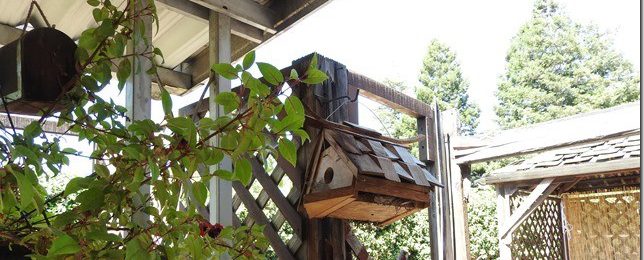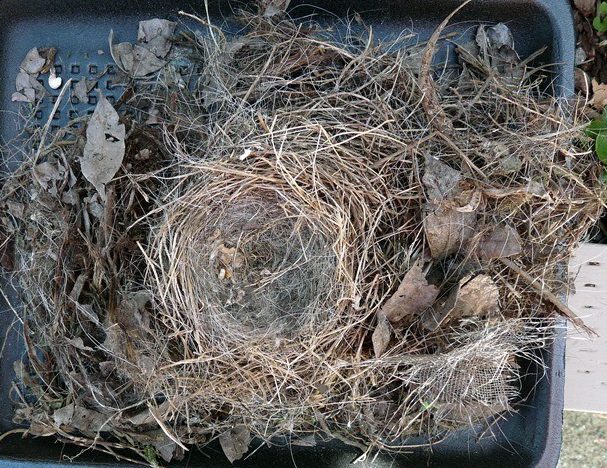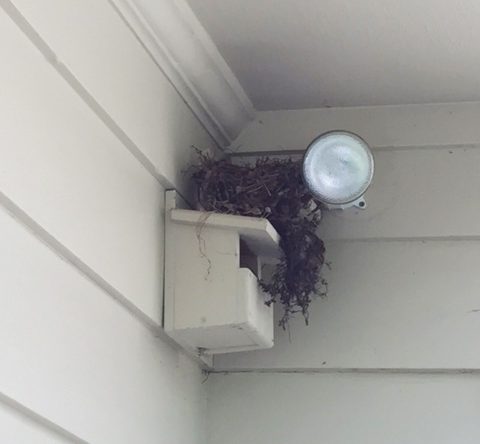 Photo ©
Denise Hamilton
Photo ©
Denise Hamilton
Last summer NestWatcher Melissa Sherwood surprised us with the first ever report of a Dark-eyed Junco nesting in an enclosed nest box. Juncos are typically open-cup nesting birds that build nests on the ground. Well, we had another surprise this summer! Cornell Lab member Denise Hamilton of Napa Valley, California, discovered our second report of a junco in a nest box! Notice that this nest is much larger, filling the space of the nest box. Below, Denise relays the details:

Junco Nest Removed From Birdhouse
This nest was removed from the birdhouse containing one deceased junco nestling (not shown).
My husband, David, and I have become known as “the birders” at our church, so it isn’t surprising when someone asks us a bird question or shows us a picture of a bird to identify it. However, I was surprised this time when my friends Laura and Tom Schmiegel asked me on May 21, 2017, “What is this bird nesting in our box?” It was a dark, tiny picture on a phone, but I could clearly make out that it was a Dark-eyed Junco! I told them that juncos don’t nest in boxes and asked if we could come over to verify and take a picture or two. Of course, an hour or two later, the birds had fledged and we missed them!
We started looking online and only came up with one confirmed nesting in a box—that of the NestWatch project in April 2016. I quickly got in contact with biologist Robyn Bailey of NestWatch, and we emailed back and forth about whether or not it was really juncos nesting in the box. Luckily our friends were willing to give me their box so I could remove the nest. Getting the nest out of a decorative bird box wasn’t easy, but it proved that it was indeed a junco nest (sadly, it held an almost fully-feathered nestling that had died). I truly find it amazing that after finding no records of juncos nesting in boxes, that in the time span of two years, NestWatch now has two! I just wish it would have happened in my yard!

Rooftop View
This open-fronted nest box in Ohio has had Dark-eyed Juncos nesting both within it (2009) and on top of it (2016).
Denise raises the interesting question of whether we are witnessing a trend. It’s difficult to know if juncos have been nesting in old woodpecker holes and other cavities, unseen by humans, for thousands of years. But we do feel cautiously confident that nesting in birdhouses is a relatively new expression of this behavior. One lucky NestWatcher named John Barber witnessed Dark-eyed Juncos nesting in an open-fronted nest box (2009), and then a different pair nesting on top of it (2016). John knows that it was not the same pair because the birds were individually marked with leg bands.
These three nest boxes have a few things in common: they are shallow and wide, and located in residential areas. Discoveries such as these raise the question, is there a “Dark-eyed Junco nest box” in our future?
Filed under:
Deprecated: File Theme without comments.php is deprecated since version 3.0.0 with no alternative available. Please include a comments.php template in your theme. in /nas/content/live/dnestwatch/wp-includes/functions.php on line 6031
I wish I could see juncos nesting in birdhouses, but it is probably very rare, and I couldn’t any way because the juncos go away for the summer! They were very lucky to see this!
I love my juncos, but mine too go away in the summer!
We too used to see our juncos depart for the summer but the last couple of years, they are staying later and returning earlier so that it seems they are now here all year around.
Departure in the summer months must be common here in the southeast. We used to call them snowbirds because that’s when we’d see them the most.
i wonder if someone put trackers on a whole bunch of juncos and at the end of the nesting season went to all the places the juncos went to frequently if it would reveal a few nests in tree holes or other cavities
We put up a bluebird house a few days ago and three pairs of juncos vied for it. It is now inhabited. Previously, we had had juncos in a ground nest under a slide set and their eggs disappeared.
Hi there,
When you say that it is inhabited, do you mean by the juncos? Did they make a nest this late in the year? Would love to get photos of this.
Thanks,
NestWatch staff
We were quite surprised when a Dark-eyed Junco built a nest and successfully raised 4 young in the center of a wreath enclosed by hanging ribbon next to our front door, She came back a few weeks later and had at least 3 eggs. Sadly after around a week she and the eggs vanished. We’ll keep the dried up old wreath and nest up for next season in hopes that she or another will choose to use it.
Greetings from St. John’s, Newfoundland, Canada! I am watching a junco couple build their nest in a bird house in my back yard! I couldn’t believe it – and I have watched them go in and out the house – and fight off the starlings who try and crowd them. I will try and upload a picture or video! Such a happy find!
Hi,
What kind of birdhouse did you use? I have tons of Dark-eyed juncos in my yard and I’m curious to see if they’ll nest in a nest box, I was thinking maybe a wren nest box would work?
I have a pregnant Junco that hangs out by my feeders most of the day. I bought a wren nesting box and hung it on the opposite side of the house. I also have a Dove nesting box in a carport area that I put up months ago near an old abandoned Dove nest. Tonight I went up there and a Junco flew out from it. It’s up pretty high. I was surprised a Junco went up there to find it. I’m guessing it’s the male.
Hi Leasa, It sounds like you may be seeing a Junco that has its feathers puffed up to insulate against cold weather. For many songbirds, it only takes somewhere around 18 hours for an egg to form in a bird’s oviduct before it is laid in a nest. Some birds will also use nest boxes to roost at night as a safe space to escape cold weather. It’s a bit too early for Juncos to be nesting (they usually don’t start nesting until at least April), however feel free to check your nest box once a week or so to see if there is a nest being built.
I have a pair of Dark Eyed Juncos building a nest in the eve over my deck. I have lived here for 35 years and never had a Junco nest there. House Finch yes but not a Junco. I watched them chase off a House Finch yesterday!
We have had 2 juncos building their nests (2 nest per Summer, both successes) in our clay flower pot installed on the brick wall next to our front door, about 4 1/2 ft. high from porch floor. 2 eggs in 2018, 3 successful of 4 eggs in 2019. Same pair has already staked out the pot in 2020 as “territory”. Building a birdhouse with 2″ hole now, buying a pole to install beside the cedar hedge also near door…so they can hide sometimes. Let’s see if they use it. I might finally have blooming flowers in the clay pot, instead of Junco fledglings.
Hello,
A pair of juncos built a nest on the ground next to our house in a area that gets a lot of traffic. There are four eggs. I haven’t seen them much since. Is it possible that they abandoned the nest? How often do they sit on the nest before the eggs hatch? It’s possible they come back in the evening and haven’t noticed. I live in Northern California. Thanks in advance.
Hi Nadine, Birds will generally be incubating constantly during the incubation period, but some birds do sometimes delay incubation. Unfortunately, however, if the bird was scared off of its nest too many times, then there is the possibility that the nest has been abandoned. We recommend giving the nset as much space as possible, and to use another door or avoid that area as much as you can. Check back in a couple of days to see if she is on the nest. Anytime you think you have an abandoned nest, we generally recommend waiting 4 weeks to be sure, which allows enough time for delayed incubation, and the normal incubation period. If you don’t find nestlings after those 4 weeks, the nest is likely abandoned.
Juncos have been building nests over the windows on our covered porch and we would love to help them find a “better neighborhood” for raising a family! If someone has a suggestion I’d be grateful for it.
Hi Vicki, Juncos typically nest on the ground or just above the ground in flower pots, low branches, etc. While it’s against federal law to move the nests and contents when the nest is active (because such an action almost always causes the nest to fail), once these young fledge you may wish to block the area so that the birds don’t re-nest (juncos may lay up to 3 broods per breeding season). If you have further questions, please email nestwatch@cornell.edu.